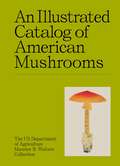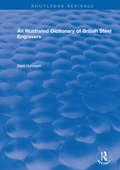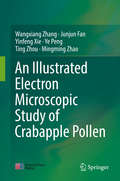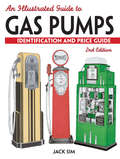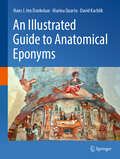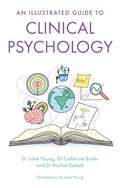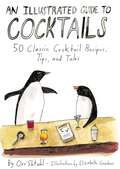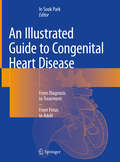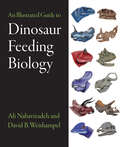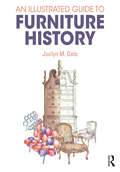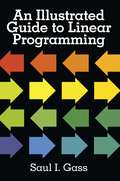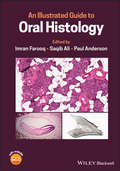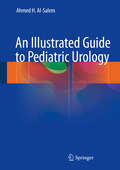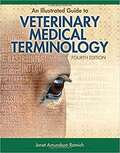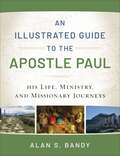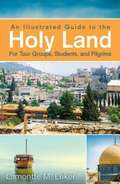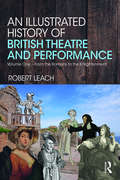- Table View
- List View
An Illustrated Catalog of American Mushrooms
by US Department of Agriculture Maurice B. Walters CollectionA fascinating exploration of the USDA&’s national fungus collection, offering readers an intimate portrait of America&’s elusive fungi species. The United States Department of Agriculture&’s National Fungus Collections is one of the world&’s largest mycological institutions, housing over a million species of fungi. Mycologist Maurice Burke Walters&’s collection of fungi is also housed here—a fascinating collection revealing the often-solitary forays of the rather-retiring Walters, the then-nascent science of mycology, and the evolving interest of the USDA in documenting the nation&’s fungi species (over 10,000 named species are found in the US). Alongside beautiful botanical illustrations, are field notes, observational sketches, and occasionally enigmatic photographs of fungi (within USDA laboratories, in the wild, and elsewhere). This book contains an eclectic assortment of illustrated and documented fungi species drawn from Walters collection. Encompassing contemporary meditations on ecology, mycology and pharmacology, the still-unexplored landscape of fungi knowledge is memorably demystified, perhaps, for practicing mycologists and enthusiastic foragers alike.
An Illustrated Dictionary of British Steel Engravers (Routledge Revivals)
by Basil HunnisettFirst published in 1989, An Illustrated Dictionary of British Steel Engravers contains more than 600 entries and an extensive plate section, providing examples of work referenced in the text and adding a clear chronological dimension to the subject. The book makes use of an array of surviving accounts and correspondence of engravers and publishers and adopts a comprehensive and systematic approach to identifying different types and variants of steel engravings over time. Equipped with a detailed introduction to the history of steel engravings, An Illustrated Dictionary of British Steel Engravers will be of great use to those interested in illustration, graphic art, Victorian literature, and the history of printing.
An Illustrated Dictionary of Dermatologic Syndromes
by Susan B. MalloryWritten by an internationally renowned researcher and teacher, this book provides a compendium of syndromes and dermatologic conditions. Completely revised and updated, the second edition includes genetic information, the genes and their loci, and the genetic linkage of certain syndromes that are now grouped with other diseases. The book retains the popular format of the first edition and includes color pictures of key syndromes from one of the major collections in the U.S. These features combine to make it an important book for office-based dermatologists who frequently see these problems in their practice and for dermatology residents who need this information to pass their boards. Describing some 716 syndromes in crisp detail with lavish color illustrations. A feature of special value is the list of carefully selected references quoted at the end of each entry to give the user ready access to definitive further reading on each syndrome. For residents and attending physicians alike, remembering and recognizing the variety of dermatologic syndromes that have been identified is a very difficult and time-consuming task. An Illustrated Dictionary of Dermatologic Syndromes provides a systematic and concise approach to the subject and is a valuable aid to both residents and attending physicians in dermatology and pediatrics. In his Foreword, Dr. Walter B. Shelley calls this, "a great book for browsing…a symphony of syndromes."
An Illustrated Dictionary of Historic Costume (Dover Pictorial Archive Series)
by James R. PlancheThousands of terms associated with apparel worn in the principal countries of Europe appear in this extensive and convenient reference. The alphabetically arranged items of clothing span nearly 2,000 years of fashion history — from the onset of the Christian era in the first century to the beginning of the reign of George III, c. 1760.From abacot, hacketon, helm, jipocoat, and jump to xainture, ysgyn, zatayn, and zibelline, the sweeping scope of this volume encompasses a remarkable range of all-but-forgotten lore. Profusely illustrated with over 1,300 detailed line drawings, it offers a useful guide for fashion and cultural historians, writers, designers, movie and theatrical producers, and all others with an interest in the history of fashion.
An Illustrated Electron Microscopic Study of Crabapple Pollen
by Wangxiang Zhang Junjun Fan Yinfeng Xie Ye Peng Ting Zhou Mingming ZhaoThis book focuses on the morphology, exine ornamentation and the associated evolutionary trends of crabapple pollen and anatomical developmental patterns. To examine the genetic evolutionary patterns of crabapple pollen traits, we constructed an interval distribution function based on characteristic pollen parameters and used a binary trivariate data matrix (Xi Yi Zi) to reflect the exine ornamentation regularity of the pollen. Our findings should inform the taxonomic status of the genus Malus.Pollen electron micrographs from a total of 26 species and 81 cultivars of Malus were recorded in this book. All 107 figures and 642 scanned pollen images constitute primary data obtained by the authors. The images in this book are clear, three-dimensional, and aesthetically pleasing. They are accompanied with text descriptions and provided a method for the indication of the different types of information that can be expected.This book can provide a reference for scientific researchers, students, and teachers in tertiary institutions that are engaged in research concerning crabapple production.
An Illustrated Encyclopaedia of Traditional Symbols
by J. C. CooperIn nearly 1500 entries, many of them strikingly and often surprisingly illustrated, J. C. Cooper has documented the history and evolution of symbols from prehistory to our own day. With over 200 illustrations and lively, informative and often ironic texts, she discusses and explains an enormous variety of symbols extending from the Arctic to Dahomey, from the Iroquois to Oceana, and coming from systems as diverse as Tao, Christianity, Judaism, Buddhism, Islam, Tantra, the cult of Cybele and the Great Goddess, the Pre-Columbian religions of the Western Hemisphere and the Voodoo cults of Brazil and West Africa.
An Illustrated Guide To Gas Pumps: Identification And Price Guide
by Jack SimWith 2,000 gas pumps, including many never-before-seen illustrations and secondary market pricing, featured in a clear and concise format, there's no doubt why An Illustrated Guide to Gas Pumps, 2nd Edition is the top choice for anyone with an appreciation for petroliana. Listed alphabetically by manufacturer, this new edition covers 100 years of pumps through detailed listings including production information, company history and fun facts about pump operations. Ultimate online gas pump site - www.oldgas.com identifies no less than 100 restored stations and petroliana museums around the U.S. and abroad Features 1,500 color illustrations, including many never-before-seen images of pumps manufactured between 1885 and 1967
An Illustrated Guide to Anatomical Eponyms
by David Kachlík Hans J. Donkelaar Marina QuartuThis book provides a comprehensive overview of the anatomical eponyms in use in anatomy and in clinical disciplines. It includes brief descriptions of those to whom eponyms were given with personal data, their relevant publications and illustrations. For the illustrations, engravings, portraits or photographs are included as well as examples of the original illustrations or newer ones showing what is meant by a certain eponym. The book contains three Sections: Section I The Classical Anatomical Eponyms, in which the major classical eponyms on arteries, bands, bodies, bundles, canals, corpuscles, ducts, fasciae, fibres, folds, foramina, fossae, ganglia, glands, ligaments, membranes, muscles, nerves, nodes, nuclei, plexuses, spaces, triangles, tubercles, valves and veins are summarized. This Section clearly shows that in various countries, different eponyms are given for the same structure. Section II lists the anatomical eponyms together with some relevant histological, embryological and anthropological eponyms, from A-Z. In Section III, anatomical eponyms in use in Abdominal Surgery, Dentistry, Neurology, Obstetrics and Gynaecology, Oncology, Ophthalmology, Orthopaedics, Otology, Phlebology, and Radiology of the Digestive System are discussed. Sections II and III are both abundantly illustrated. The book is intended for advanced medical students, anatomists, and clinicians using anatomical eponyms in their daily practice. Unique to the book is the combination of descriptions of the anatomical eponyms with illustrations.
An Illustrated Guide to Clinical Psychology
by Juliet Young Dr Rachel Paskell Dr Catherine ButlerWhat does a day in the life of a practising clinical psychologist look like? Which therapeutic approaches do they use? How do you become a clinical psychologist? Answering these questions and more, An Illustrated Guide to Clinical Psychology is ideal for aspiring, trainee, and newly qualified clinical psychologists to learn more about the field. Written by clinical psychologists, and featuring illustrations by one of the authors, Juliet Young, this accessible book explores the history and context of clinical psychology, the key skills, tools, and theoretical foundations for clinical psychologists, and the main therapeutic approaches that they use. The book navigates through the necessary components to understand the underpinning elements of the profession, with a taster of different areas that clinical psychologists work in. Through a critical lens, it also explores topical debates within the profession and addresses issues of diversity and inclusion.
An Illustrated Guide to Cocktails: 50 Classic Cocktail Recipes, Tips, and Tales
by Orr ShtuhlShaken or stirred, on the rocks or straight up, every cocktail has a unique history. Bringing this rich lore to life, An Illustrated Guide to Cocktails showcases the often romantic origin of classic and modern mixed drinks and the fascinating characters who made them famous. From the crooked gangster who inspired the Jack Rose (a drink often served in Manhattan's gilded Astor mansion during the Jazz Age) to the legendary Margarita (associated with the Tijuana dancer now known by her stage name, Rita Hayworth), the spirited blend of alcohol and alchemy is showcased on each beautifully illustrated page. The drink recipes include favorite classics (such as Old Fashion, White Russian, Sidecar) alongside forgotten standards such as the Blood and Sand. With guides to various spirits, suggestions for stocking your home bar, and mixing tips and techniques, An Illustrated Guide to Cocktails brings the marvels of mixology to every home bartender.
An Illustrated Guide to Congenital Heart Disease: From Diagnosis to Treatment – From Fetus to Adult
by In Sook ParkThis book combines an exceptional wealth of precise, exquisite schematic drawings and high-quality images with clear explanatory text in order to provide readers with a crisp and clear understanding of all aspects of congenital heart disease, from diagnosis to treatment and from the fetus to the adult. In format the book appears similar to a large collection of case reports covering all types of congenital heart disease, including complex lesions such as single ventricle and atrial isomerism. For each lesion, the illustrations are placed before the text so that the reader can gain a quick and general overview before going into more detail. The contents are as practical and concise as possible. The intention is that, despite its size, the book will serve as a handy reference for cardiologists, surgeons, intensivists, obstetricians specializing in fetal sonography, nurses, trainees, students, researchers, and even patients and their families. This is a “must-have” bedside reference in the cardiac ward, the ICU, and the fetal sonography room and will even be valuable in outpatient clinics.
An Illustrated Guide to Dinosaur Feeding Biology
by David B. Weishampel Ali NabavizadehThis beautifully illustrated exploration of the diversity, anatomy, and evolution of dinosaur feeding adaptations is the first and only in-depth look at this crucial aspect of paleoecology.In An Illustrated Guide to Dinosaur Feeding Biology, experts Ali Nabavizadeh and David B. Weishampel bring dinosaurs to life on the page by exploring and illustrating their feeding adaptations. Whether dinosaurs were carnivorous, herbivorous, or omnivorous, their evolution produced a multitude of specialized adaptations that helped shape their ecologies. Dinosaur skulls show a variety of bone and joint specializations ideal for withstanding stresses and strains induced by high bite forces with strong jaw musculature. The bladed, steak-knife dentition of many carnivorous dinosaurs was well-suited for slicing meat and crushing bones, while the leaf-shaped, sometimes tightly packed dentition of many herbivorous dinosaurs was ideal for grinding up a variety of plant material.The first book of its kind, An Illustrated Guide to Dinosaur Feeding Biology is a synthesis of over a century of dinosaur feeding biology research, from the earliest hypotheses in the 1800s to today's studies using advanced techniques. Intended for both researchers and dinosaur enthusiasts alike, this book discusses functional morphological studies highlighting comparative anatomy, tooth wear, muscle reconstruction, and biomechanical analysis using modeling techniques like finite element analysis and multibody dynamics analysis. In addition to the feeding apparatus, Nabavizadeh and Weishampel explore postcranial adaptations and discuss the evolution of dinosaurs and their paleoecology more broadly. Integrating these various factors improves our understanding of dinosaurs as the living beings they were in their ecosystems millions of years ago and ultimately expands our knowledge and perspective of today's ecosystems by framing them in a broader evolutionary context.
An Illustrated Guide to Furniture History
by Joclyn M. OatsAn Illustrated Guide to Furniture History provides upper-level students and instructors with an alternative visual analytical approach to learning about furniture history from Antiquity to Postmodernism. Following an immersive teaching model, it presents a Nine-Step Methodology to help students strengthen their visual literacy and quickly acquire subject area knowledge. Moving chronologically through key periods in furniture history and interior design, such as the Renaissance, the Arts and Crafts Movement, and Modernism, it traverses Europe to America to present a comprehensive foundational guide to the history of furniture design. Part I addresses furniture within the context of the built environment, with chapters exploring the historical perspective, construction principles, and the categorization of furniture. In Part II, the author visually depicts the structural organization of the methodological process, a three-category framework: History, Aesthetics, and Visual Notes. The chapters in this part prepare the reader for the visual analysis that will occur in the final section of the book. The book is lavishly illustrated in full color with over 300 images to reinforce visual learning and notation. A must-have reference and study guide for students in industrial and product design, interior design, and architecture.
An Illustrated Guide to Linear Programming
by Dr Saul I. Gass"I would not hesitate to recommend the book." -- Industrial Engineering. Entertaining, nontechnical introduction covers basic concepts of linear programming and its relationship to operations research; geometric interpretation and problem solving, solution techniques, network problems, much more. Appendix offers precise statements of definitions, theorems, and techniques, additional computational procedures. Only high-school algebra needed. Bibliography.
An Illustrated Guide to Oral Histology
by Paul Anderson Saqib Ali Imran FarooqLearn more about the histological presentation of diseased and normal oral tissues with this high definition illustrated dental reference An Illustrated Guide to Oral Histology delivers a collection of high-definition histological and pathological images, presenting both diseased and normal oral tissues. The book provides over 200 high-magnification histomicrographs of oral tissues, as well as definitions and explanations of key identifying histological and pathological features of oral tissues. Readers will also benefit from explanations of the clinical significance of particular features, numerous images of ground sections, haemotoxylin- and eosin-stained sections, and electron images. It also includes core topics such as: An introduction to tooth development, including the bud, cap, early bell, and late bell stages A thorough exploration of enamel, dentin, cementum and dental pulp A discussion of the periodontal ligament, including alveolar crest fibers, horizontal, oblique, apical, and inter-radicular fibers, transseptal fibers, and gingival fibers A guide to alveolar bone, oral mucosa, and salivary glands Perfect for postgraduate dental students, An Illustrated Guide to Oral Histology will also be useful to undergraduate dental students, and those looking to improve their understanding of the microscopic structure of dental tissues and their pathologies.
An Illustrated Guide to Pediatric Surgery
by Ahmed H. Al-SalemWritten in a simple point by point style for ease of use, this volume covers all aspects of pediatric surgery with emphasis on important points for diagnosis and management. Each chapter covers a topic with emphasis on the most common conditions in neonatal and general pediatric surgery. The text is well illustrated with clinical, operative, radiological, and histopathological color figures and illustrations. The book also presents some of the rare conditions encountered in pediatric surgery, as well as common pediatric urology conditions. An Illustrated Guide to Pediatric Surgery is a useful reference to pediatric surgeons, specialists, fellows and residents, as well as general surgeons, pediatricians, neonatologists, medical students and interns interested in pediatric surgery.
An Illustrated Guide to Pediatric Urology
by Ahmed H. Al-SalemThis book is vital for physicians caring for young patients with urological conditions, as a quick reference book that is easy to read and well-illustrated. Pediatric urological conditions are fairly common, and infants and children are seen on daily basis with urological problems either in clinics or in hospitals. This book is useful to general surgeons, pediatricians, pediatric surgeons, fellows, residents, general physicians and family physicians, medical students and nurses. The Editor has gained experience in the diagnosis and management of various urological problems in infants and children, working in busy hospital over the last 25 years.
An Illustrated Guide to Relativity
by Tatsu TakeuchiAimed at both physics students and non-science majors, this unique book explains Einstein's special theory of relativity pictorially, using diagrams rather than equations. The diagrams guide the reader, step-by-step, from the basics of relativity to advanced topics including the addition of velocities, Lorentz contraction, time dilation, the twin paradox, Doppler shift, and Einstein's famous equation E=mc2. The distinctive figures throughout the book enable the reader to visualize the theory in a way that cannot be fully conveyed through equations alone. The illustrative explanations in this book maintain the logic and rigour necessary for physics students, yet are simple enough to be understood by non-scientists. The book also contains entertaining problems which challenge the reader's understanding of the materials covered.
An Illustrated Guide to The Lost Symbol
by John WeberRich in world history and political power, veiled in secrecy, and rife with rituals and arcane symbols -- from art and architecture to the images that adorn our currency -- the Freemasons arose from ambiguous origins centuries ago to play a major role in drafting the initial documents of the United States, and even in constructing the intricate landscape of Washington, D.C., itself a virtual mystery by design. These puzzles lay the foundation for Dan Brown's serpentine thriller, The Lost Symbol, and also raise provocative questions. Why do some Masonic symbols remain obscured, while others are hidden in plain sight? Which presidents were the embodiments of Masonic ideals? What is the significance of the construction of the Library of Congress, Washington National Cathedral, the Washington Monument, the Capitol, and the physical layout of Washington, D.C.'s roadways and cul-de-sacs? And to what secretive end do they all lead? Now millions of curious fans can follow Robert Langdon step-by-step, and discover for themselves the answers to the absorbing conundrums posed by The Lost Symbol in this comprehensive, fully illustrated, and intricately detailed tour of the arcana of Washington, D.C. It takes readers through the enigmatic codes, captivating trivia, unfathomable riddles, intriguing records, historic maps, ciphers, and conspiracies of the phenomenal bestseller. What's more, it reveals the fascinating details of a world of unknown locales, mysticism, intrigue, and secret societies -- all of which lie in the shadow of The Lost Symbol.
An Illustrated Guide to Veterinary Medical Terminology
by Janet Amundson RomichProviding the ultimate terminology reference for veterinary assistants and technicians, AN ILLUSTRATED GUIDE TO VETERINARY MEDICAL TERMINOLOGY, 4e provides an engaging, systematic approach to learning medical terms and understanding basic principles of veterinary medicine. This user-friendly textbook delivers a unique pedagogical presentation that makes it a comprehensive learning resource. Focusing on how medical terms are formed, analyzed, and defined, the text discusses anatomical landmarks, the positioning of animals, and the relationships between body parts. It also introduces terms used in the animal industry. Case studies illustrate how medical terminology is experienced in real-world practice, and an audio wordlist enables readers to hear the terms they are learning.
An Illustrated Guide to Veterinary Medical Terminology (3rd edition)
by Janet Amundson RomichA systematic approach to breaking down the parts of medical terms is used, allowing readers to grasp basic medical concepts and apply critical thinking skills when faced with new and unfamiliar medical terminology.
An Illustrated Guide to the Apostle Paul: His Life, Ministry, And Missionary Journeys
by Alan S. BandyThis fascinating, full-color visual guide to the life of Paul explores the social, cultural, political, religious, and historical background of the world in which he lived and ministered, offering modern readers an engaging narrative of the man who laid the foundations of the first-century church.
An Illustrated Guide to the Holy Land for Tour Groups, Students, and Pilgrims
by Lamontte M. LukerAs the geographic heart and soul of Judaism, Islam, and Christianity, the Holy Land has immense significance for the millions of visitors each year. But since the fifth century BC, enthusiastic and curious people have needed a guide as they travel to see the sites for themselves.This book is different because it not only gives the historical, archaeological descriptions wedded to the biblical text, but it is an appropriate resource for spiritual formation and cross-cultural dialog.Packed with the latest information, this book locates and introduces the reader to popular and less-familiar sites such as Bethlehem, Shepherds’ Field, Church of the Nativity, Roman Catholic Church of St. Catherine, the Herodium, Mount of Olives, Old City of Jerusalem, Wadi Kelt, Mt. Sinai, Church of the Holy Sepulchre, the site of Church of St. Mary of the Latins, Temple Mount, El-Aksa Mosque, Dome of the Rock, Hezekiah's Tunnel, the traditional place of the Last Supper, Siloam Pool, the traditional tomb of King David, the house of Caiphas the High Priest, Shrine of the Book, Herod's Antonio Fortress, Golgotha, Bethany, Tomb of Lazarus, Bethphage, Pater Noster Church, Gethsemane, and many others. Each entry explains the history and topography of the site as well as its function and significance as it is linked to the relevant biblical passages.This book will not only inform you but help you better understand your faith. Journey to the Holy Land with indispensable archaeological information linked to the biblical story.
An Illustrated Handbook of Horse and Pony Care
by Tim Hawcroft Jane KiddAnyone who owns a horse or who works with horses and ponies knows the importance of ensuring that they are healthy, well-behaved, and well-disciplined. This is more easily said than done; like humans, horses are individuals and they often have specific care and management problems. Some of these problems are inherent in their physiological makeup; others may be man-made because of the environment provided. Still others may be caused by accident or by infection. The Illustrated Encyclopedia of Horse and Pony Care is an authoritative and practical guide to all aspects of looking after the horse and pony. It is designed to meet the needs and stimulate the interests of anyone involved with horses and ponies - from parents buying their child's first pony to breeders and trainers. The book is divided into four main sections, beginning with Buying a Horse. Each aspect for consideration in this section is presented on a double- page spread including conformation, temperament, and identification. Color photographs are combined with superb color paintings to provide a thorough guide to colors and natural markings. The second section, Handling the Horse, includes step-by-step instructions and accompanying photographs on how to approach, catch, and lead a horse; various methods of restraint for adults and foals; how to transport your horse by road, rail, sea, or air. There are beautifully detailed illustrations showing the various types of saddles and bridles, sequences of color photographs showing the correct way to put on the tack, and useful advice on how to care for this valuable equipment. The next section which is the main focus of the book, concerns the healthy horse. Guidelines are set out for daily care, including feeding, grooming, and exercise with important points presented in charts for quick and easy reference. Periodic care includes worming and teeth care, with chapters on shoeing and vaccination. Vital first-aid techniques are explained with clear, easy-to-follow instructions. One of the most important features of the book is its coverage of specific health problems. Drawing on his extensive knowledge and sound veterinary practice, Tim Hawcroft has illustrated and enumerated the most common and easily-recognizable illnesses and accidents that a horse may suffer from. These diseases and problems are arranged from A-to-Z with details of signs, symptoms, and treatment given for each ailment. The fourth and final section of the book discusses breeding. There are chapters on selection and management of the stallion and mare; preparation for the service; pregnancy diagnosis including details of the latest ultrasound techniques; a series of color photographs illustrating the various stages of foaling; advice on how to care for the mare after foaling; common diseases and problems of foals with full details of treatment; and, finally, specific care requirements of youngstock.
An Illustrated History of British Theatre and Performance: Volume One - From the Romans to the Enlightenment
by Robert LeachAn Illustrated History of British Theatre and Performance chronicles the history and development of theatre from the Roman era to the present day. As the most public of arts, theatre constantly interacts with changing social, political and intellectual movements and ideas, and Robert Leach’s masterful work restores to the foreground of this evolution the contributions of women, gay people and ethnic minorities, as well as the theatres of the English regions, and of Wales and Scotland. Highly illustrated chapters trace the development of theatre through major plays from each period; evaluations of playwrights; contemporary dramatic theory; acting and acting companies; dance and music; the theatre buildings themselves; and the audience, while also highlighting enduring features of British theatre, from comic gags to the use of props. This first volume spans from the earliest forms of performance to the popular theatres of high society and the Enlightenment, tracing a movement from the outdoor and fringe to the heart of the social world. The Illustrated History acts as an accessible, flexible basis for students of the theatre, and for pure fans of British theatre history there could be no better starting point.
